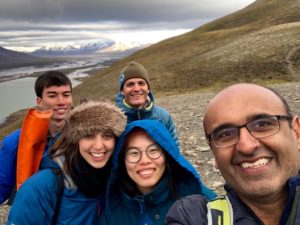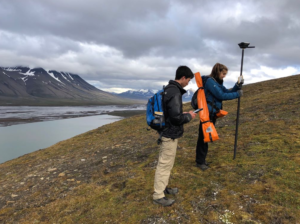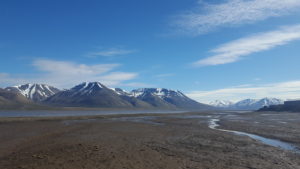What a course! I came to Svalbard hoping to learn about plant traits, conduct research with my team, and experience the high Arctic for the first time. The course managed to exceed my expectations on all fronts. Through the lectures, I began to understand how studying plant traits enables a more predictive ecology as ecosystems respond to climate change. I especially enjoyed Sean’s lecture, which demonstrated how to combine a theoretical approach to predicting leaf temperature with field-based data collection and linked these to the importance of considering leaf temperature rather than just atmospheric temperature when thinking about vegetation productivity. As someone who typically studies phenomena at larger scales, these ideas were a nice reminder that our understanding of landscapes are incomplete without considering the detailed functioning of the abiotic and biotic components.
In the remote sensing team, we designed novel approaches to scaling up plant traits and collected and processed a wealth of data (>300 GB!). It was an incredible two weeks, in which every day we were trying out new methods and software, refining our approach, and producing new outputs demonstrating how the landscape looks once we zoom out and how spectral signatures can link the different spatial scales of investigation. There are many lines of research open to us with our data, such as mapping different species (vascular plants and bryophytes!) and investigating the influence of microtopography on species distributions and productivity. There is also much opportunity for collaboration, and I am excited to continue working with the others on the course.
Personally, I had forgotten how much I missed fieldwork. I love the routine of working in a small team day after day, contributing to different components of the project and constantly making leaps and bounds. To some extent, I even enjoy the time pressure of field work that forces consideration of how much data collection is feasible and which loose ends must be tied up before leaving the field. It was an excellent two weeks working with a great team.
In Svalbard, it seemed clear that most people believe the planet is warming and that anthropogenic activities are the primary cause. However, my sense is that many people don’t really understand the mechanisms behind climate change, as they conflated the problem of climate change with that of plastic pollution. More investigation would be needed to test understanding of climate change, but I do think it is perhaps a global issue that people think of “the environment” as a singular entity rather than trying to understand the many challenges and possible routes to addressing them. Still, it was encouraging that the topic of climate change was not as controversial or political in Svalbard as it is in the US.
Although I conducted surveys with people, it was a bit disappointing how impersonal they felt. Rarely did I engage in dialogue with the people I met, but rather just handed them the survey and received it back. Additionally, I think the survey could have dug deeper into the issue of climate change as it pertains to Svalbard. I understand that the survey’s purpose is to compare perceptions across the world, but we could have addressed interesting local tensions, such as how Norway’s possession of Svalbard is made possible because of their oil riches. Although it is outside the scope of the course, semi-structured interviews might provide interesting insights into people’s perceptions of their own identity and privilege regarding the causes and impacts of climate change.
Overall, I am very grateful to have been on the course, and I am confident that what I learned will benefit me for years to come. It was great to spend time with an impressive international cohort, and I look forward to crossing paths with many of them again.


